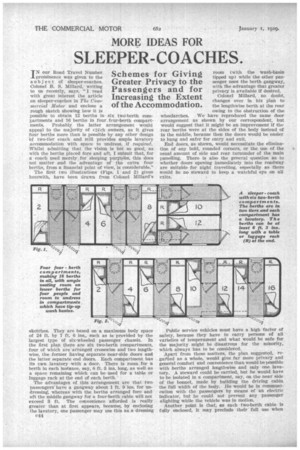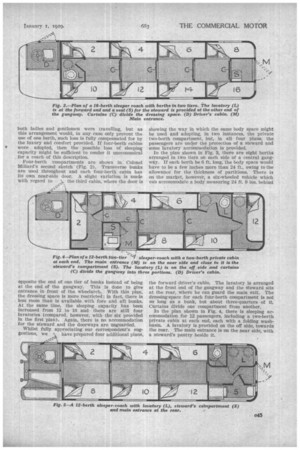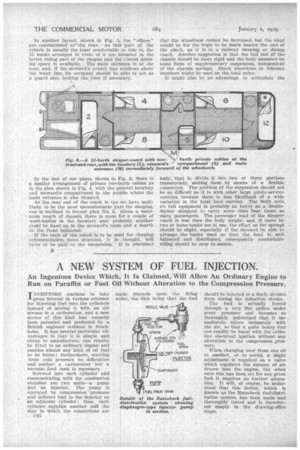MORE IDEAS FOR
Page 44

Page 45

Page 46

If you've noticed an error in this article please click here to report it so we can fix it.
SLEEPER-COACHES.
IN our Road Travel Number prominence was given to the subjeet of sleeper-coaches. Colonel B. S. Millard, writing to us recently, says, "I read with great interest the article on sleeper-coaches in The Commercial Motor and enclose a rough sketch showing how it is possible to obtain 12 berths in six two-berth compartments and 16 berths in four,four-berth compartments. Probably the latter arrangement would appeal to the majority of etech owners, as it gives four berths more than is possible by any other design "of two-tier coach and still provides ample lavatory accommodation with space to undress, if required. Whilst admitting that the vision is not so good, as with the berths placed fore and aft, I submit that, for a coach used merely, for sleeping purpoies, this does not matter and the advantage of the extra four berths, from a financial point of view, is considerable."
The first two illustrations (Figs. 1 and 2) given herewith, have been drawn from Colonel Millard's sketehes. They are based on a maximum body space of 24 ft. by 7 ft. 6 ins., such as is provided by the largest type of six-wheeled passenger chassis. In the first plan there are six two-berth compartments, four of which are 'arranged crosswise and two lengthwise. the former having separate near-side doors anl the latter separate end doors. Each compartment has Its own lavatory with a door. There is room for a berth in each instance, say, 6 ft. 3 ins, long, as well as a space remaining which can be used for a table or luggage rack at the end of each berth.'
The advantages of this arrangement are that two passengers havea gangway about 1 ft. 9 ins, for undressing, whereas with the berths arranged fore and aft the middle gangway for a four-berth cabin will not exceed a ft. The convenience afforded is really greater than at first appears, because, by enclosing the lavatory, one passenger may use this as .a dressing e44 room (with the wash-basin tipped up) while the other passenger uses the berth gangway, with the advantage that greater privacy is available if desired.
Colonel Millard, no doubt, changes over in his plan to the lengthwise berth at the rear owing to the obstruction of the wheelarches. We have reproduced the same door arrangement as shown by our correspondent, but would suggest that it might be an improvement if the rear berths were at the sides of the body instead of in the middle, because then the doors would be easier to hang and safer for entry and exit.
End doors, as shown, would necessitate the elimination of any bold, rounded corners, or the use of the usual amount of side and rear turnunder of the main panelling. There is also the general question as to whether doors opening immediately into the roadway are suitable for night travelling, especially as there would be no steward to keep a watchful eye on all exits.
Public service vehicles must have a high factor of safety, because they have to carry persons of all varieties of temperament and what would be safe for the majority, might be disastrous for the minority, which always has to be considered.
Apart from these matters, the plan suggested, regaited as a whole, would give far more privacy and general comfort and convenience than would bevossible with berths arranged lengthwise and only one lavatory. A steward could be carried, but• he would have to be isolated in a compartment, say, on the near side of the bonnet, made by building the driving cabin the full width of the body. He would be in communication with the passengers by means of 'an electric indicator, but he could not prevent any passenger alighting while the vehicle was in motion.
Another point is that, as each two-berth cabin Is fully enclosed, it may preclude their full use when
both ladies and gentlemen were travelling, but as this arrangement would, in any case only prevent the use of one berth, such loss is fully compensated for by the luxury and comfort provided. If four-berth cabins
• were adopted, then the possible loss of sleeping capacity might be sufficient to render it uneconomical for a coach of this description.
Four-berth compartments are shown in Colonel Millard's second sketch (Fig. 2). Transverse bunks are used throughout and each four-berth cabin has its own near-side door. A slight variation is made with regard to • the third cabin, where the door is opposite the end of one tier of bunks instead of being at the end of the gangway. This is done to give entrance in front of the wheelarch. With this plan, the dressing space is more restricted; in fact, there is less room than is available with fore and aft bunks. At the same time, the sleeping capacity has been increased from 12 to 16 and there are still four lavatories (compared, however, with the six provided in the first plan). Again, there is no accommodation for the steward and the doorways are unguarded.
Whilst fully appreciating our correspondent's suggestions, we • have prepared four additional plans,
showing the way in which the same body space might be used and adopting, in two instances, the private two-berth compartment. but, in all four plans, the passengers are under the protection of a steward and some lavatory accommodation is provided.
In the plan shown in Fig. 3, there are eight berths arranged in two tiers on each side of a central gangway. If each berth be 6 ft. long, the body space would have to be a few inches more than 24 ft., owing to the allowance for the thickness of partitions. There is on the market, however, a six-wheeled vehicle which can accommodate a body measuring 24 ft. 9 ins. behind the forward driver's cabin. The lavatory is arranged at the front end of the gangway and the steward sits at the rear, where he can guard the main exit. The dressing-space for each four-berth compartment is not so long as a bunk, but about three-quarters of it. Curtains divide one compartment from another.
In the plan shown in Fig. 4, there is sleeping accommodation for 12 passengers, including a two-berth private cabin at each end, each with a folding washbasin. A lavatory is provided on the off side, towards the rear. The main entrance is on the near side, with a steward's pantry beside it. In another layout, shown in Fig. 5, the " offices " are concentrated at"the rear. .As this part of the vehicle is usually the least comfortable to ride in, the 12 hunks arranged in front of it are mounted in the better, riding part of the chassis and the ttmost dressing space is available. The main entrance is at the rear, and, if the steward's pentrY has windows above the waist line, its occupant should be able to act as a guard also, locking the door if necessary.
In the last of our plans, shown in Fig. 6, there is a similar arrangement of private two-berth cabins as in the plan shown in Fig. 4, with the general lavatory. and steward's compartment in the .middle where the main entrance is also situated.
As, the rear end of the coach is (as we have said) likely to be the Most uncomfortable part for sleeping, one is Inclined to favour. plan No. 5. Given a maximum length of chassis, there is room for a couple of wash-basins in the lavatory and probably another could 'be fixed up in the steward's room and a fourth on the front bulkhead.
• 'ff the backof tile coachis to be used for eleeping accommodation, more attention, it is .thought, will have to be paid to the. 'suspension. It is presumed that the wheelbase cannot be increased, but the Ideal wthild be for the bogie to be much nearer the end of the cdacb, as it is in a railway sleeping or dining coach, Another suggestion is that the tail end of tha chassis should be more rigid and the body mounted on some form of supplementary suspension, independent of the chassis springs; Shock absorbers or rebound snubbers might be used on the hind axles.
It might also be an advantage to articulate the body, that is, divide it into two or three portions transversely, vniting them by means of a flexible connection. The problem of the suspension should not be as difficult as it is with other large public-service vehicles, because there is less likelihood of a wide variation in the total load carried. The body with
its full equipment • probably as heavy as a doubledecker designed to carry more .than four times as many passengers. The passenger load of the sleepercoach is less than the body weight, and, if there be two or three bunks not in use, the effect on the springs should be slight, especially if thesteward be able to arrange the bunks Used so that the . load is.. well balanced and distributed, consequently comfortable riding should be easy to ensure.
















































